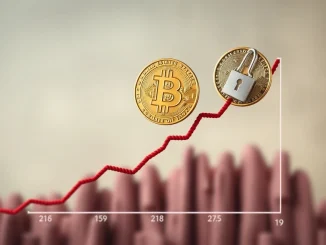
Imagine a world where financial transactions, currently taking days, happen in seconds. This isn’t a futuristic dream but a rapidly unfolding reality, spearheaded by giants like BNY Mellon and Goldman Sachs. Their recent foray into **tokenized funds** is not just an incremental update; it’s a foundational shift set to revolutionize a colossal $5.7 trillion market.
The Rise of Tokenized Funds: A $5.7 Trillion Opportunity
The financial world is buzzing with the news: BNY Mellon and Goldman Sachs have officially launched tokenized Money Market Funds (MMFs). This groundbreaking initiative leverages cutting-edge blockchain technology to enable real-time settlement and significantly enhance liquidity within the massive $5.7 trillion MMF market. The collaboration is a strategic alliance between BNY’s established LiquidityDirect platform and Goldman’s innovative GS DAP® blockchain, which is built on Digital Asset’s Canton technology.
This partnership allows institutional investors to subscribe to and redeem MMF shares as digital tokens. This marks a pivotal moment, showcasing a deep integration of traditional finance (TradFi) infrastructure with advanced crypto capabilities. What’s more, this isn’t a niche experiment; it’s backed by major asset management powerhouses, including BlackRock, Fidelity, and Federated Hermes, signaling a robust and growing institutional confidence in the future of **tokenized funds**.
Driving Institutional Crypto Adoption: How It Works
So, how do these **tokenized funds** actually operate? They function via mirrored tokens on a permissioned private ledger. These digital tokens represent direct ownership of traditional MMF shares, but with a crucial difference: they unlock a suite of advanced functionalities previously unimaginable in conventional finance. Here’s a quick look at the immediate benefits:
- 24/7 Market Access: Unlike traditional MMFs, which adhere to strict banking hours, tokenized versions are accessible around the clock.
- Instant Settlements: Traditional MMFs often require T+1 or T+2 settlement periods. The blockchain-based approach reduces transaction times to mere seconds, vastly improving capital efficiency.
- Programmable Use Cases: These tokens can be programmed for various functions, such as automated collateral pledging, streamlining complex financial operations.
Laide Majiyagbe, BNY’s Global Head of Liquidity, Financing, and Collateral, aptly stated that this innovation “opens doors to scalable, secure real-time finance.” This move is specifically designed to cater to **institutional crypto** adoption, focusing on the needs of large-scale players rather than public retail markets at this stage.
Unlocking the Power of Blockchain Finance for Liquidity
At the heart of this innovation lies Goldman Sachs’ GS DAP platform, powered by Digital Asset’s Canton blockchain technology. While the tokens generated are not currently tradable on public markets, the platform is an integral part of the broader Canton Network—a decentralized infrastructure supported by a consortium of global financial institutions. This suggests significant potential for future expansion into decentralized exchanges (DEXs) and seamless cross-chain settlements.
Mathew McDermott, Goldman’s Global Head of Digital Assets, highlighted that these tokens “unlock new utility as collateral and transferability.” This capability is a game-changer for **blockchain finance**, offering unparalleled flexibility and efficiency in managing institutional liquidity. The focus remains squarely on institutional clients, ensuring robust security and compliance.
This strategic move also aligns perfectly with evolving regulatory landscapes. For instance, the 2025 GENIUS Act, which banned interest-bearing stablecoins, has created a substantial demand for regulated, yield-generating alternatives. Tokenized MMFs offer a compliant and attractive solution for parking idle cash, drawing interest from hedge funds, corporations, and other traditional financial institutions. Moody’s projects record asset growth in this sector for 2025, underscoring its strategic value in an increasingly digital financial ecosystem.
The Future of Digital Assets: Collateral and Beyond
The ability of these **digital assets** to serve as instant collateral is a monumental step forward. Imagine the efficiency gains for large corporations or hedge funds that need to quickly deploy capital or manage risk. This isn’t just about faster transactions; it’s about fundamentally transforming how capital moves and is utilized within the financial system.
The underlying technology enables traditionally siloed back-office systems to become interoperable, real-time networks. This means less manual reconciliation, fewer errors, and significantly reduced operational costs. While the current implementation focuses on private, permissioned networks, the long-term vision clearly includes broader adoption. This could eventually lead to integration with decentralized finance (DeFi) platforms and public crypto rails, further blurring the lines between traditional and digital finance.
Seamless TradFi Integration: Bridging Worlds
This partnership between BNY Mellon and Goldman Sachs is more than just a product launch; it represents a foundational shift towards true **TradFi integration** with the burgeoning world of digital assets. By prioritizing institutional-grade security and ensuring regulatory readiness from the outset, these financial giants are positioning tokenized MMFs as a vital bridge between the stability and robustness of traditional finance and the speed, efficiency, and programmability of crypto infrastructure.
This convergence promises to unlock new efficiencies, enhance liquidity, and create innovative financial products that were previously impossible. The journey towards a fully digital and interconnected financial system is accelerating, and initiatives like this are paving the way for a more agile, secure, and accessible global financial landscape.
Conclusion
The introduction of tokenized Money Market Funds by BNY Mellon and Goldman Sachs is a landmark event in the evolution of finance. It signifies a powerful convergence of traditional financial strength with cutting-edge blockchain technology, promising to redefine liquidity management and asset transfer. As institutional confidence in digital assets grows and regulatory frameworks mature, we can expect to see an even broader adoption of these innovative solutions, truly transforming how capital flows in the global economy. This isn’t just a glimpse into the future; it’s the future arriving now.
Frequently Asked Questions (FAQs)
1. What are tokenized Money Market Funds (MMFs)?
Tokenized Money Market Funds are traditional MMF shares represented as digital tokens on a blockchain. This allows for faster settlement, enhanced liquidity, and programmable features, bridging conventional finance with blockchain technology.
2. How do tokenized MMFs differ from traditional MMFs?
The primary difference lies in settlement speed and accessibility. Traditional MMFs typically have T+1 or T+2 settlement periods, while tokenized MMFs can settle in seconds, offering 24/7 access and new programmable use cases like instant collateral pledging.
3. Which major financial institutions are involved in this initiative?
BNY Mellon and Goldman Sachs are leading this initiative, with support from major asset managers such as BlackRock, Fidelity, and Federated Hermes, indicating broad institutional backing.
4. What are the key benefits of tokenized MMFs for institutional investors?
Key benefits include 24/7 market access, instant settlements, enhanced liquidity, reduced operational costs, and the ability to use MMF shares as programmable collateral, all within a regulated and secure environment.
5. Are these tokenized funds tradable on public crypto exchanges?
Currently, these tokenized funds operate on permissioned private ledgers (like Goldman’s GS DAP) and are not tradable on public crypto exchanges. The focus is on institutional clients within a controlled environment, though future expansion to broader networks is envisioned.
6. How does this initiative align with current regulations?
This initiative is designed to be regulatory compliant, offering a regulated yield-generating alternative, especially in light of regulatory shifts such as the 2025 GENIUS Act which banned interest-bearing stablecoins, creating demand for compliant cash management solutions.



